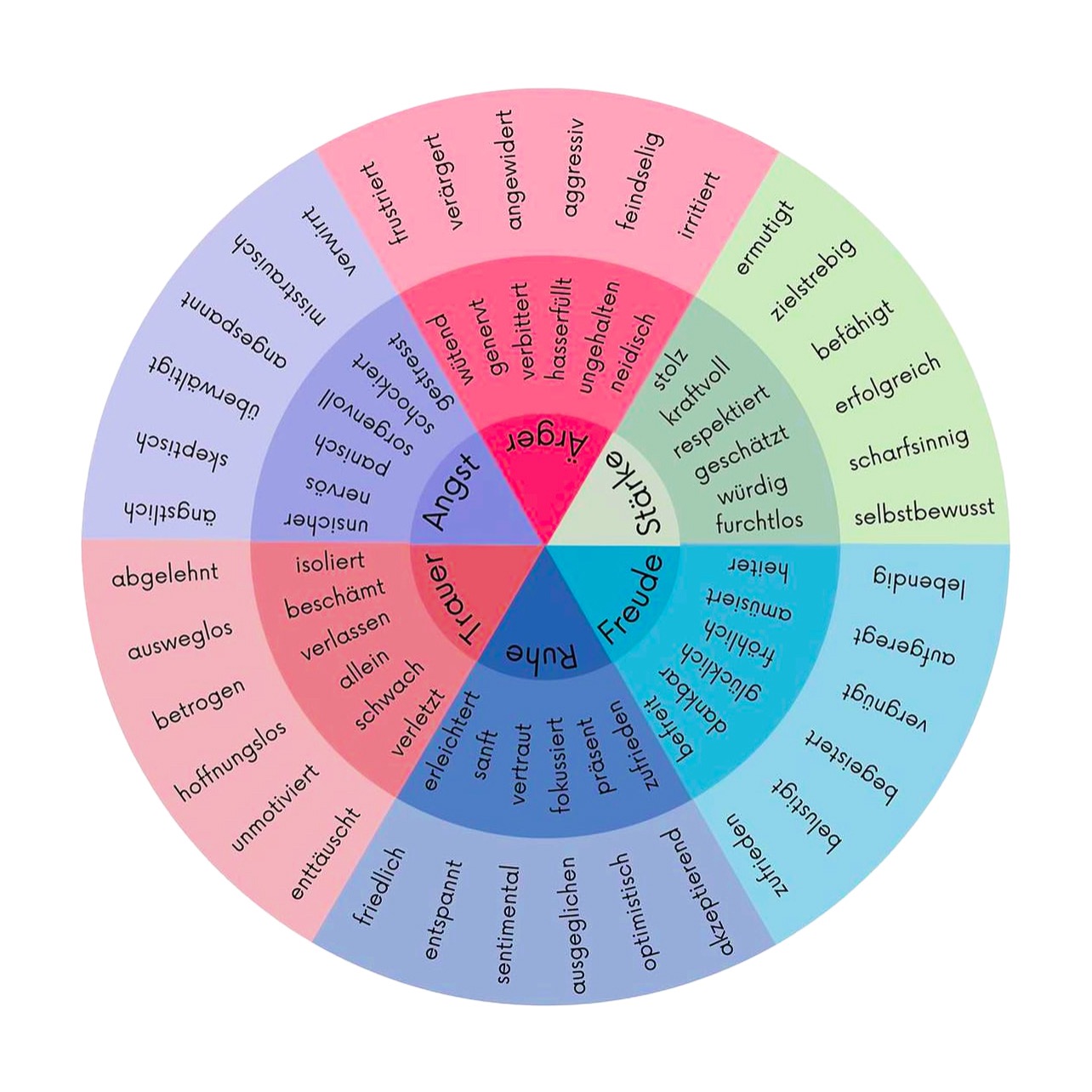
Why the emotion wheel can deepen your understanding of feelings
Imagine you had a compass that didn't show you the points of the compass, but the directions of your emotional world. This is exactly what the emotion wheel is - a tool that can help you to explore and understand the diverse landscapes of your emotions. It is like a colour wheel that not only shows basic colours, but also their many shades. Just as you create new tones by mixing colours, the emotion wheel helps you to recognise that even simple feelings such as joy or sadness can have many nuances.
In a world where the internet is often our first port of call for information, the Emotion Wheel offers an easily accessible and understandable method to better interpret our emotional states. You can find numerous online sources that explain and visualise the concept. These sources confirm that it is not uncommon to sometimes not know exactly what we are feeling.
The emotion wheel is particularly valuable if you are looking for support and perhaps find it difficult to put your feelings into words. It offers you a language for what is going on in your heart - for what you may not have been able to express before. When you learn to name and understand your feelings, you open the door to greater self-knowledge and empathy - key components for a healthy emotional life and supportive conversations at REDEZEIT FÜR DICH.
The structure of the emotion wheel
When you look at the emotion wheel for the first time, it may look like a colourful kaleidoscope representing complex patterns of emotions. It is a circle in which each emotion has its place, similar to the hours on a clock. The centre of the wheel shows the basic feelings, from which each emotion moves along a scale to finer gradations. Blue perhaps stands for sadness and leads to various shades ranging from a feeling of dejection to despair. These colour and emotional gradations are not arbitrary - they are based on psychological theories and research that can be found online in numerous academic and popular science articles.
The five ways in which colours reflect our emotions:
The five ways colours reflect our emotions:aBlue for sadness: Like a calm but deep ocean.
Red for anger: Like the blazing intensity of a fire.
Green for calm: Like the soothing effect of a forest.
Yellow for joy: Like the brightness of a sunny day.
Grey for fear: Like the foggy veil of uncertainty.
The connections between the emotions on the bike are carefully thought out. They show how one emotion can transition into another, for example how frustration can turn into anger. This transition is fluid and individually different, which is often discussed in the online community. Blogs, forums and even online courses offer a wealth of information and application examples that can help you to utilise the structure of the emotion wheel for yourself.
Basic emotions: The basis of the wheel
The four basic emotions - joy, sadness, anger and fear - are the pillars of the emotion wheel. They are universal; everyone in this world has felt them. Joy is lively and warm, a feeling that is often associated with bright colours. Sadness feels heavy and dark, anger is intense and demanding, and fear can be cold and paralysing. These basic emotions have been analysed in numerous psychological studies, which you can also find online. They show how these emotions are processed in our brain and how they influence our behaviour and decisions.
The next time you feel overwhelmed by one of these basic emotions, it can be helpful to research and learn how other people deal with them. The internet is full of resources - from support groups to professional counselling services that can offer you strategies to deal with these strong emotions.
From basic emotions to specific feelings
On the emotion wheel, each basic emotion is broken down into more subtle feelings. Joy branches out into happiness, contentment or euphoria, while sadness can turn into melancholy, loneliness or despair. These finer distinctions are important because they allow you to understand and express your emotional state more accurately. In the world of online psychology and self-help, it is often emphasised how important it is to not just say that you are 'sad', but to identify the specific type of sadness. It can be liberating to find the right word for a feeling you may be harbouring deep inside.
10 examples of emotion spectra:
From joy to ecstasy.
From sadness to despair.
From interest to fascination.
From surprise to shock.
From trust to admiration.
From anticipation to anticipation.
From acceptance to peace.
From disgust to revulsion.
From anger to rage.From fear to panic.
Recognising and naming emotions
Naming your emotions is an act of self-care and self-understanding. It's like shining a torch into the dark corners of your inner self. The emotion wheel gives you this torch. It helps you to turn "I don't feel good" into "I feel discouraged because...". This precision in emotional self-disclosure is a topic often discussed in self-help forums and psychology articles. Many experts emphasise how important it is to identify emotions accurately in order to process them effectively.
7 steps to better name your emotions:
Stop and pay attention to how you feel.
Describe the physical sensations you are experiencing.
Identify the situation that triggered the feeling.
Think about the thoughts you have about this feeling.
Choose the emotion that fits best from the emotion wheel.
Use specific adjectives to describe the intensity.
Talk about it or write it down to gain clarity.
The emotion wheel in practice: use cases
The emotion wheel is not just a theoretical exercise - it has real life applications. Teachers use it to help students articulate their emotions in the classroom. Therapists use it to help clients recognise and overcome their emotional blocks. Coaches use it to empower their clients to recognise and use their emotional strengths. And, of course, people use it at home to understand and manage their own emotional responses.
6 situations in which the emotion wheel can be helpful:
In a conflict discussion, to express your feelings clearly.
During a mediation to understand the emotions of all parties.
In personal goal setting to identify motivations.
At school, to help students with emotional self-regulation.
In therapy, to work on deep-rooted emotions.
In self-coaching to develop self-awareness and empathy.
Developing emotional intelligence with the emotion wheel
Emotional intelligence is the ability to recognise, understand and manage emotions in yourself and others. The Emotion Wheel can help you develop this skill. There are exercises you can do to explore the connections between different emotions and understand how one emotion can transition into another. These exercises are easy to find on the internet and can be done at home or in guided workshops. By engaging with the Emotion Wheel, you will build a deeper understanding of your emotional world and improve your ability to interact with others in an empathic way.
Criticism and limitations of the model
As helpful as the emotion wheel may be, it is not without its critics. Some experts point out that it cannot capture all the cultural nuances of emotions. It is important to realise that the emotion wheel is a model - a simplified representation of a much more complex reality. The scientific community continues to debate the best ways to classify and understand emotions, and you can find these discussions in professional journals and online forums. These resources can help you develop a critical understanding of the limitations of the emotion wheel.
Conclusion: The emotion wheel as a guide to emotional clarity
The Emotion Wheel is a powerful tool on your journey to emotional clarity. It provides a structure to help you navigate the often confusing world of emotions. Through the internet and its myriad of resources, you have access to a community of people experiencing similar challenges. With the Emotion Wheel, you can learn to recognise, name and ultimately master your emotions, giving you a deeper understanding of yourself and the people around you.
Sources:
THE EMOTION THEORY OF ROBERT PLUTCHIK: https://homepage.univie.ac.at/michael.trimmel/proseminar/emotion/texte/dieemotionstheorievonrobertplutchik.html
How to use an emotion wheel to get in touch with all your feelings: https://www.gesundlinie.com/health/emotion-wheel

About the authors
The editorial team of REDEZEIT FÜR DICH is a team of mental health experts, professional coaches and dedicated writers who are committed to sharing knowledge and insights around the topic of mental wellbeing. With a deep understanding of the challenges of modern life and a wealth of experience in supporting people in crisis, the editorial team provides content that informs, inspires and shows ways to personal fulfilment.
In the articles by the REDEZEIT FÜR DICH editorial team, readers will find a carefully curated mix of practical advice, in-depth reflections and motivating stories. Each article is written with the aim of encouraging readers to prioritise their mental health, strengthen their resilience and build a supportive network.
The REDEZEIT FÜR DICH editorial team is always open to suggestions, feedback or personal stories that you would like to share with us. We are here to support, share and pave the way to a mentally healthy community together.
